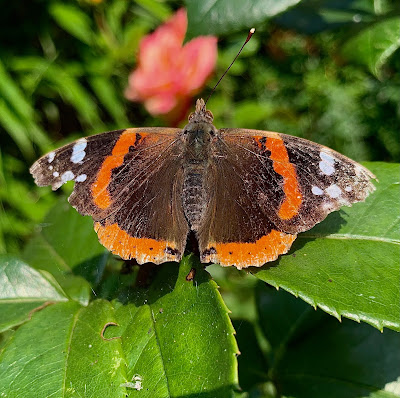Birds seen along the Strood channel late morning during the high tide included six Mediterranean gulls, two common terns, marsh harrier, two lapwing and three turnstones.
A fresh looking painted lady was feeding in the Feldy View on Friday, also seen were meadow brown, gatekeeper, small white and small / Essex skipper.
On Thursday 22nd a newly fledged juvenile sparrowhawk was heard calling loudly in The Lane, West Mersea.
At Feldy View on Thursday Steve Entwistle saw a peregrine fly-over, kestrel, grey heron, also possible southern hawker and southern migrant / migrant hawker, 7 ruddy darters, small skipper and two gatekeepers.
Lots of sand martins were flying around the country park on Wednesday with up to 300 seen either in the air, near the cliff, or sitting on the beach at the Point.
Four little terns flew up the Colne past the Point and then headed into the Pyefleet. One common tern flew over, twelve Mediterranean gulls roosted on the saltmarsh, also an avocet, black-tailed godwit and a turnstone noted. A marsh harrier was seen over Ivy Farm and ten little egrets seen with most roosting at the park pond.
A sedge warbler perched in view near the park seawall on Wednesday and another one was heard singing by the pond. A Cetti's warbler sang by the dyke and a tufted duck and pochard both with ducklings were present, along with 20+ small-eyed damselflies on the dyke.
A sedge warbler perched in view near the park seawall on Wednesday and another one was heard singing by the pond. A Cetti's warbler sang by the dyke and a tufted duck and pochard both with ducklings were present, along with 20+ small-eyed damselflies on the dyke.
Several predatory bee-wolves were watched at the East Mersea Point, some carrying their prey of solitary bees which they carried into their holes in the sandy soil.
A well marked male whinchat was a nice find by the Strood seawall on Tuesday 20th. The bird showed a pale orange upper chest, as well as the dark face, white stripe above the eye and a large white patch on each wing. The bird was seen in the evening by Steve Entwistle who watched it in the wheat field. This individual is one of the earliest returning whinchats for the Island.
Another early returning autumn migrant was a willow warbler by the flycatcher corner at Feldy View.
Two corn buntings were singing by the Strood seawall on Tuesday, reed warbler, yellow wagtail and four whitethroats were also seen. Along the channel were a marsh harrier, 70 redshank, whimbrel and forty curlew.
Steve also saw in the evening a meadow pipit, six linnets, sedge warbler with grown young, whitethroat, three corn buntings and a yellow wagtail with two young.
An obliging clouded yellow was spending time feeding on a clump of lesser knapweed in Feldy View on Tuesday. Also a fresh painted lady seen, meadow brown, gatekeeper, small heath, ringlet, small white, small /Essex skipper, red admiral and peacock.









No comments:
Post a Comment